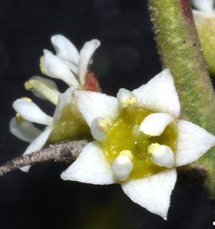Floral biology of Adolphia infesta and the reproductive profile of Colletieae (Rhamnaceae)
DOI:
https://doi.org/10.26786/1920-7603(2015)12Abstract
The reproduction of the shrub Adolphia infesta was studied in a population included in a Mexican agricultural landscape with small, cultivated plots and fragments of natural habitat. Adolphia infesta had reproductive traits consistent with those known for its tribe Colletieae, including small zoophilous flowers exposed to both xenogamous, geitonogamous and visitor-facilitated intrafloral pollination, with selfing being at least partially hindered by self-incompatibility. Visual and olfactory cues, together with easily accessible rewards (nectar and pollen), explain the diversity (68 species of 29 families) of insects attracted to the flowers. However, only a small subset can be considered potential pollinators (honeybee and three muscoid flies). In late floral development, pedicel bending brings the developing fruit to an upright position, which might later optimise explosive seed dispersal. The finding of this trait in A. infesta makes fruit erection a synapomorphy of the Adolphia – Discaria – Kentrothamnus clade of the tribe Colletieae. At the study site, A. infestaplayed a significant role as food source for the local anthophilous insect community, and through its flower visitors, the plant was indirectly connected to 11 other plant species. Knowledge derived from community studies should be applied in conservation initiatives directed at enhancing farmers’ appreciation of extant local biodiversity.
Downloads
Published
2015-05-27
How to Cite
Medan, D., Castillo-Campos, G., & Zarlavsky, G. (2015). Floral biology of Adolphia infesta and the reproductive profile of Colletieae (Rhamnaceae). Journal of Pollination Ecology, 16, 82–90. https://doi.org/10.26786/1920-7603(2015)12
Issue
Section
Articles
License
Copyright (c) 2015 Diego Medan, Gonzalo Castillo-Campos, Gabriela Zarlavsky

This work is licensed under a Creative Commons Attribution 4.0 International License.











